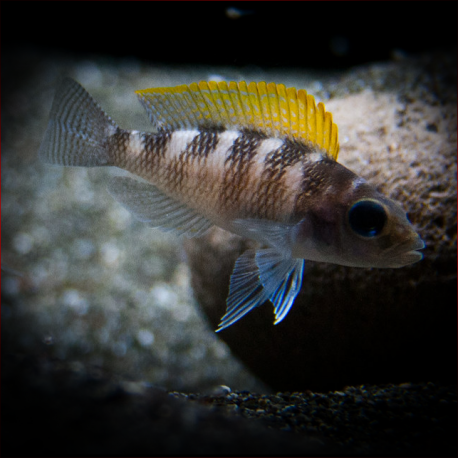More info
Datasheet
| Minimum Tank Size | 120 litres / 31.70 US gallons |
| Maximum Size | 106cm / 41.73inches |
| Temperament | Aggressive |
| Care Description | Easy |
| Temperature | 22.2°C / 71.96°F - 27.8°C / 82.04°F |
| Carbonate Hardness | 10-20 |
| pH | 7.8-9.0 |
General Description
The Lamprologus Caudopunctatus Cichlid, also known as the Neolamprologus Caudopunctatus Cichlid, hails from the rocky Zambian coastal waters of Lake Tanganyika in Africa. This species boasts a silver body with a tan tint and eye-catching blue and yellow accents on the dorsal and anal fins, adding a touch of drama to their appearance. With a maximum size of 3.5 inches, they are among the smaller cichlids.
Aquarium Setup
When setting up an aquarium for Lamprologus Caudopunctatus Cichlids, it is recommended to have a tank of at least 30 gallons in size, ideally with other smaller Tanganyikan cichlids. To replicate their natural habitat, incorporate a variety of rocks, shells, and African driftwood to form caves. A sandy bottom with aragonite is essential to maintain the required high pH and alkalinity levels, crucial for their well-being and breeding needs.
See table for water conditions.
Behaviour
Known for their aggressive temperament, Lamprologus Caudopunctatus Cichlids can be territorial, especially during breeding periods. They are substrate spawners, exhibiting a slow growth rate that can delay sexual maturity for a couple of years. Males tend to be larger than females, creating a noticeable size difference within the species.
Feeding and Diet
Being carnivores, the diet of Lamprologus Caudopunctatus Cichlids should consist of meaty foods such as bloodworms, brine and mysis shrimp, as well as carnivore-specific flake and pellet foods. Offering a variety of these items ensures a balanced nutritional intake for these fish.
Reproduction & Dimorphism
Breeding Lamprologus Caudopunctatus Cichlids can be challenging due to their slow growth and specific requirements. Males, larger than females, engage in substrate spawning, with females laying eggs in shells or directly on the sandy bottom. After an incubation period of 3 to 4 days, it is advisable to move the fry to a separate tank to enhance their survival rate. Newly hatched fry can be fed with brine shrimp and finely crushed flake food.
Habitat and Distribution
Preferring the rocky coastal waters of Lake Tanganyika in Zambia, Africa, Lamprologus Caudopunctatus Cichlids are commonly found in this region. Their natural habitat includes ample hiding spots among rocks and crevices, which can be replicated in the aquarium environment to promote their well-being and natural behaviors.

